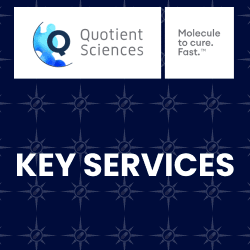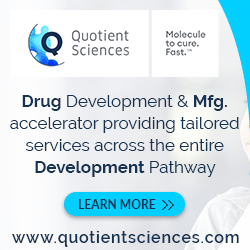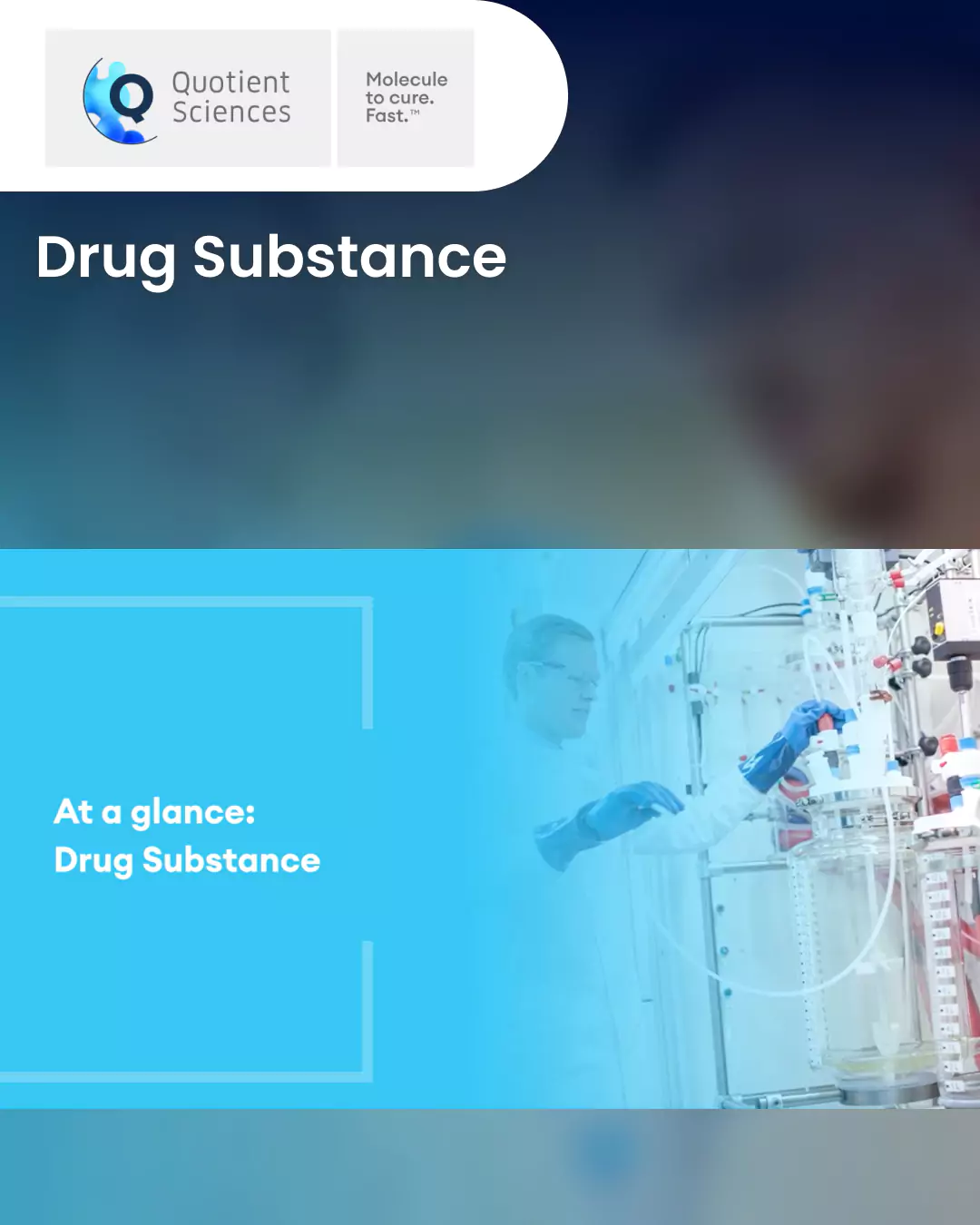21 Mar 2025
// PRESS RELEASE
27 Feb 2025
// PRESS RELEASE
07 Feb 2025
// PRESS RELEASE
 KEY SERVICES
KEY SERVICES
Quotient Sciences- Molecule to Cure. Fast.
About
CPhI North America CPhI North America
Industry Trade Show
Booth #1220
20-22 May, 2025
Global DDF SummitGlobal DDF Summit
Industry Trade Show
Attending
02-04 June, 2025
BIO International Conv...BIO International Convention
Industry Trade Show
Attending
16-19 June, 2025
CONTACT DETAILS




Events
Webinars & Exhibitions
CPhI North America CPhI North America
Industry Trade Show
Booth #1220
20-22 May, 2025
Global DDF SummitGlobal DDF Summit
Industry Trade Show
Attending
02-04 June, 2025
BIO International Conv...BIO International Convention
Industry Trade Show
Attending
16-19 June, 2025
https://www.pharmacompass.com/speak-pharma/translational-pharmaceutics-our-flagship-platform-for-drug-development-empowers-our-clients-with-unparalleled-flexibility
CORPORATE CONTENT #SupplierSpotlight
https://www.pharmacompass.com/radio-compass-blog/cdmo-activity-tracker-bora-polpharma-make-acquisitions-evonik-euroapi-porton-announce-technological-expansions
https://www.pharmacompass.com/radio-compass-blog/cdmo-activity-tracker-novo-s-parent-buys-catalent-for-us-16-5-bn-fujifilm-merck-kgaa-axplora-lonza-expand-capabilities

21 Mar 2025
// PRESS RELEASE
https://www.quotientsciences.com/news/quotient-sciences-completes-14-million-project-improve-high-potency-handling-philadelphia-pa

27 Feb 2025
// PRESS RELEASE
https://www.quotientsciences.com/news/quotient-sciences-recognized-winner-2025-cdmo-leadership-awards

07 Feb 2025
// PRESS RELEASE
https://www.quotientsciences.com/news/nazim-kanji-contributes-taste-masking-insights-article-pharmtech

01 Feb 2025
// PRESS RELEASE
https://www.quotientsciences.com/news/quotient-sciences-announces-successful-inspection-boothwyn-pa-facility-chinese-national

01 Jan 2025
// PRESS RELEASE
https://www.quotientsciences.com/news/nanomerics-reports-complete-dosing-last-volunteer-oc134-sunlight-trial

11 Dec 2024
// PRESS RELEASE
https://www.quotientsciences.com/news/quotient-sciences-and-nanomerics-dose-first-volunteers-oc134-sunlight-trial
Services
Analytical
Clinical Trials
API Manufacturing
Drug Product Manufacturing
Pharma Service : Drug Product Manufacturing
Pharma Service : Drug Product Manufacturing
Pharma Service : Drug Product Manufacturing
Category : Tablet
Sub Category : High Potency APIs (HPAPIs)
Pharma Service : Drug Product Manufacturing
Pharma Service : Drug Product Manufacturing
Category : Tablet
Sub Category : Clinical Supply
Pharma Service : Drug Product Manufacturing
Pharma Service : Drug Product Manufacturing
Category : Tablet
Sub Category : Controlled / Immediate / Modified Release
Pharma Service : Drug Product Manufacturing
 FULL SCREEN VIEW Click here to open all results in a new tab [this preview display 10 results]
FULL SCREEN VIEW Click here to open all results in a new tab [this preview display 10 results]API & Drug Product Development
Pharma Service : API & Drug Product Development
Category : API Development
Sub Category : Biocatalysis
Pharma Service : API & Drug Product Development
Pharma Service : API & Drug Product Development
Category : API Development
Sub Category : Process Development & Optimization
Pharma Service : API & Drug Product Development
 FULL SCREEN VIEW Click here to open all results in a new tab [this preview display 10 results]
FULL SCREEN VIEW Click here to open all results in a new tab [this preview display 10 results]Pharma Service : API & Drug Product Development
Category : Preformulation & Material Science
Sub Category : Overview
Pharma Service : API & Drug Product Development
Pharma Service : API & Drug Product Development
Category : Preformulation & Material Science
Sub Category : Polymorph & Crystal Screening
Pharma Service : API & Drug Product Development
Pharma Service : API & Drug Product Development
Category : Preformulation & Material Science
Sub Category : Salt Screening
Pharma Service : API & Drug Product Development
Pharma Service : API & Drug Product Development
Category : Preformulation & Material Science
Sub Category : Solid State Characterization
Pharma Service : API & Drug Product Development
 FULL SCREEN VIEW Click here to open all results in a new tab [this preview display 10 results]
FULL SCREEN VIEW Click here to open all results in a new tab [this preview display 10 results]Pharma Service : API & Drug Product Development
Category : Formulation Development
Sub Category : Buccal / Orodispersible
Pharma Service : API & Drug Product Development
Pharma Service : API & Drug Product Development
Category : Formulation Development
Sub Category : Capsule
Pharma Service : API & Drug Product Development
Pharma Service : API & Drug Product Development
Category : Formulation Development
Sub Category : Compounding
Pharma Service : API & Drug Product Development
Pharma Service : API & Drug Product Development
Category : Formulation Development
Sub Category : Controlled / Immediate / Modified Release
Pharma Service : API & Drug Product Development
Pharma Service : API & Drug Product Development
Category : Formulation Development
Sub Category : Topical
Pharma Service : API & Drug Product Development
Pharma Service : API & Drug Product Development
Category : Formulation Development
Sub Category : Granule / Pellets
Pharma Service : API & Drug Product Development
Pharma Service : API & Drug Product Development
Category : Formulation Development
Sub Category : Inhalation / Nasal
Pharma Service : API & Drug Product Development
Pharma Service : API & Drug Product Development
Category : Formulation Development
Sub Category : Injectable / Parenteral
Pharma Service : API & Drug Product Development
Pharma Service : API & Drug Product Development
Category : Formulation Development
Sub Category : Lipid Formulation
Pharma Service : API & Drug Product Development
Pharma Service : API & Drug Product Development
Category : Formulation Development
Sub Category : Overview
Pharma Service : API & Drug Product Development
 FULL SCREEN VIEW Click here to open all results in a new tab [this preview display 10 results]
FULL SCREEN VIEW Click here to open all results in a new tab [this preview display 10 results]Packaging
Inspections and registrations
ABOUT THIS PAGE




